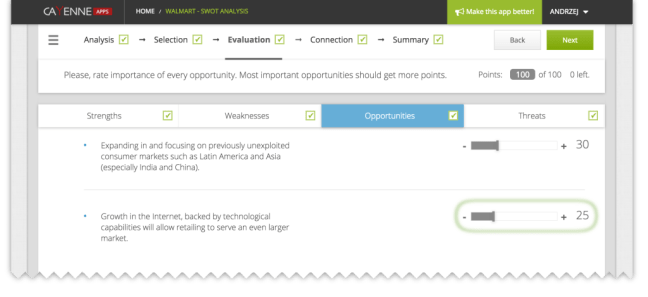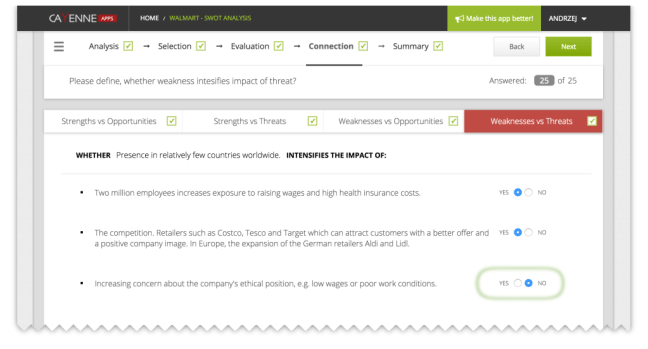The article is based on Walmart SWOT analysis, which can be found in the Library, in CayenneApps SWOT application.
First of all, I must admit that in CayenneApps we really do love SWOT analysis! It may be a bold confession nowadays when everything which is new and shiny is better, but it is true.
What’s not to love? SWOT is simple, powerful and proven to be effective. It encourages people to think more carefully about their businesses and decisions.
Even though SWOT is more than 50 years old, its potential still very often remains untapped. In this article, I want to show how, using our SWOT application, you can squeeze much more from your analysis and transform your regular SWOT into a true strategic planning tool.
Why should I care?
I have seen a lot of SWOTs available online. Most of them were only more or less visually attractive matrixes comprised of four lists of features: strengths, weaknesses, opportunities, and threats. These were the same matrixes that I saw when I was studying economics at my university.
In CayenneApps, our goal is different. The objective is to convert these lists into a concrete strategy recommendation for your business and give you meaningful insights into your venture. Conducting this kind of process helps you to understand not only what your strengths or threats are, but also how they interact with each other and which of them have the biggest impact on your work.
Sounds challenging? Thankfully, we have managed to make this process much easier.
But, enough with the introduction, let’s get down to work! You can use this link and begin your analysis process now.
Analysis
In CayenneApps SWOT, the entire analysis process is divided into four steps: analysis, selection, evaluation, and connection.
The main goal of the first step is to identify the various features of your business, namely: strengths, weaknesses, opportunities, and threats — just like in regular SWOT.
But, the problem with a majority of “regular” SWOT analyzes is that people think too much about what to put on these lists. We suggest a different approach. Use this step as a brainstorming session! No pressure. Put whatever you think is appropriate without analyzing whether one feature is more important than the other. Use the input fields in each box and type in as many features as you like — new features will appear below. You can edit them and remove them whenever you like.
Selection
When you have listed all your features, now is the time to select which ones you think are the most important. Why? Selection is important because it allows you to focus better. Let’s say that your company has ten different weaknesses and ten different threats. Can you imagine addressing all of them at once?
In Cayenne, all you need to do is to browse through four main feature categories and, using checkboxes, select up to five of the most important items in each category. Then, click on “Next” and proceed to the next step.
Evaluation
In this step, you need to create a ranking of selected features. Why? Even though you have already made a pre-selection, it is a rare situation when all of the features are equally important. Some opportunities can be more promising than others. Some strengths are more important to you than others…
Sole prioritization is not always enough; therefore, in CayenneApps we have created a ranking system which allows you to assign wages to each feature. For each category (strengths, weaknesses and so on…) you have 100 points to hand out.
Use the sliders next to each feature and assign points to them. At any point in time, Cayenne will be informing you how many points you still have to hand out. Based on your wages, the application will normalize the results and rank the features proportionally in the background.
Connection
The purpose of the fourth and last step is to define the relationships between features. In this step, you have the ability to define how the internal attributes of your venture affect the surrounding environment. For example, your task is to ask yourself whether a particular strength allows you to use a particular opportunity or whether it allows you to overcome a particular threat.
To facilitate the process, the application creates for you a special questionnaire which contains a set of automatically prepared questions with only two possible answers: yes or no. This greatly speeds up the entire step. All you need to do is to mark the answers to all the questions. The application will immediately inform you as to how many questions have been answered, and how many questions are left.
When you finish, just use the “Next” button and proceed to the summary.
Strategy
Now, we can ask ourselves a question: how do all these rankings and relationships actually translate into a strategy for the company? Previously, I have said that defining the connections between features is essential. Why? Surprisingly, a recommended strategy for the company very often can be extrapolated from the strengths of relationships existing between internal and external features.
For example, on the one hand, a strong relationship between strengths and opportunities can be a reason to execute an aggressive strategy. On the other hand, when our weaknesses are strongly connected with our threats it may be a reason to execute a different strategy — a defensive one.
Strategic planners name four different types of these strategies. Besides aggressive and defensive ones, there is also diversification (conservative) and turnaround (competitive). Each of them has a different set of properties and eventually suggests a different type of action.
Sadly, as I said before, the large number of SWOT analyzes done across the world lacks the transformation described above. Why? Because, defining all these relationships, calculating their impact on each other and analyzing the outcome is too tedious.
But I have good news! Thankfully, our SWOT tool does all this difficult work for you! Whenever you finish your analysis process, you will receive a summary of whatever you typed in automatically, in less than a second!
Above you can see a fragment of a sample summary of the analysis. What does the summary include? It not only recommends a particular strategy for you, but also explains the distribution of all strategies and the strengths of different types of relationships. The tool shows you also how strong your strengths are, compared with how much your weaknesses impact your environment.
Moreover, the application using the “influence factor” shows you which of your internal features has the biggest influence on the strategy. The “impact factor” shows you which of your strengths and weaknesses have the biggest impact on your opportunities and threats combined.
Personally, I think that the knowledge included on the summary page is far more powerful than the basic lists of features usually associated with SWOT.
Summary
That’s all! This was our method for performing the SWOT analysis more thoughtfully. Have you ever done it this way? Do you like it? Share your opinion in comments. Happy SWOT analyzing!
And last but not least, please visit our website CayenneApps and begin transforming your SWOTs into a long-term business strategy.


[…] I wanted to find out what is best for me, I created a SWOT analysis for working in a corporate job. I discovered that my present job has a predominance of weaknesses, […]
I think, its already explained in TOWS matrix !!
Hi Sunil,
TOWS is a great complement to the process we have described above. It gives you a view from a different perspective and for sure enhances the analysis process. By the way — implementing TOWS in CayenneApps is on our roadmap 🙂
Thank you for that. I however, love this and use this in my business all the time. I did an MMU business course and this was one of the first things they had us doing.
Fab.
Sharon
Hi Sharon!
Thanks for your comment! I am excited to see that there are a lot of other people who also use and love SWOT as we do 🙂
Thanks for the insight! A SWOT analysis is key to having a healthy business!
[…] is to help small businesses to start up efficiently. Previously, we showed you how to create a SWOT analysis based on examples of enterprise commercial giants such as Amazon or Walmart, and trending startups […]
[…] I wanted to find out what is best for me, I created a SWOT analysis for working in a corporate job. I discovered that my present job has a predominance of weaknesses, […]
[…] 4 steps to transforming a SWOT analysis into your strategy […]